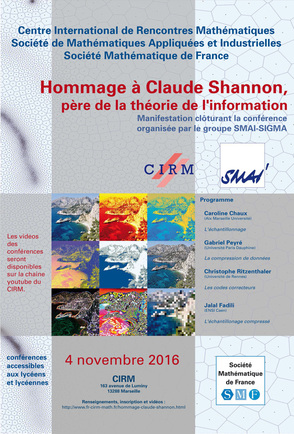SIGMA’2016 (Signal-Image-Géométrie-Modélisation-Approximation)
31 octobre au 4 novembre 2016
|
La rencontre SIGMA’2016 est proposée par le groupe thématique SIGMA de la SMAI. Ce groupe a pour objectif de développer des liens forts entre diverses communautés scientifiques, au-delà de frontières parfois artificielles, et de créer ainsi, au sein de la SMAI, une synergie autour des thèmes Signal-Image, Géométrie Algorithmique, Modélisation Géométrique, Approximation. Cette rencontre est donc conçue prioritairement pour aider à fédérer des actions de recherche autour des thématiques ci-dessus en permettant un partage efficace de connaissances/outils et l’interaction effective entre ces communautés. Le partage de connaissances se fera grâce à 20 exposés invités de synthèse d’une heure environ, par des spécialistes internationaux de premier plan dans les thématiques SIGMA. Elle comportera aussi de 30 à 40 communications orales (30mn) ou posters, dont une forte proportion par jeunes chercheurs ou thésards.
|
Comité scientifique
Albert Cohen (Université Pierre et Marie Curie) Comité d’organisation Bernhard Beckermann (Université Lille I) |
|
Conférenciers
Convergence of dimension elevation algorithms : only a typical CAGD issue?
Low Distortion Inter-surface Mapping via Optimal Mass Transport
Rational approximation of the algebraic functions and functional analogs of the Diophantine approximants
Hardy-Hodge decomposition of vector fields
Protected triangulations
(Another) convex representation of curvature-dependent energies in 2D
A proximal algorithm for third order tensor decomposition and application to fluorescence spectroscopy
Christoffel-Darboux-type formulae for orthonormal rational functions with arbitrary complex poles
Rational interpolation of analytic functions
Shortest path embeddings of graphs on surfaces
Shape modeling based on similarity analysis
Exponential weighted aggregation for group-analysis sparse regression: risk bounds and sampling algorithms
ADMM in Imaging Inverse Problems: Some History and Recent Advances
Perturbation and fast recompression of low-rank tensors
Products of random matrices: explicit formulas and asymptotics
Multilevel quadratic spline quasi-interpolation and application to numerical integration
Inverse potential problems for elliptic PDE, with physical applications
Using Generalized B-splines in Isogeometric Analysis
Reduction and reconstruction of complex spatio-temporal data
Transferring Information across Image and Model Collections
The Shannon Total Variation
Statistical methods for high-dimensional function approximation in tree-based tensor formats
A unified approach to Nevanlinna-Pick interpolation problems
A theoretical framework for the analysis of Mapper
The flash-lag effect as a motion-based predictive shift Estimates in Best Polynomial Approximation on the Unit Ball
A Geometric Smooth Approach to Image Labeling
Clustering Dynamic Data Streams
Multi-degree smooth polar splines: a framework for design and analysis
Variational Models for Restoring Manifold-Valued Images
Using machine learning techniques in geometric modeling
X-rank and identifiability for a polynomial decomposition model
CLEAR: Covariant LEAst-square Re-fitting with applications to image restoration
Kernel-Based Approximation Methods and their Applications
Modified Logarithmic Potential Theory and Applications |
Session posters
Denoising synthetic aperture radar images: Application to interferogram
Low-rank SDP’s for Sparse Spikes Deconvolution
Scaling Algorithms for Unbalanced Optimal Transport
Support Recovery for Sparse Deconvolution of Positive Measures
A new nonconvex variational approach for sensory neurons receptive eld estimation
Image restoration and segmentation using the Ambrosio-Tortorelli functional and discrete calculus
Accurate quasi-automatic 3D reconstruction of human body shape from biplanar X-rays using a statistical shape model
Stochastic Optimization for Large Scale Optimal Transport
Bayesian Network Models for Satellite Image Classification
On the retrieval of high-resolution images
Seismic image segmentation for objects retrieval
Hyperspectral and multispectral image fusion based on optimal transport
Restoration of compressed images
Convex super-resolution detection of lines in images
Spectral Shape Analysis of the Human Brain Surface
Cut-Pursuit for Convex Inverse Problems with Piecewise Constant Regularization
On the coupling of decimation operator with subdivision schemes for multiscale analysis |

